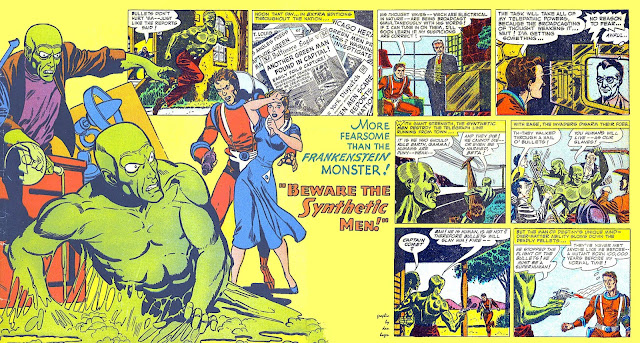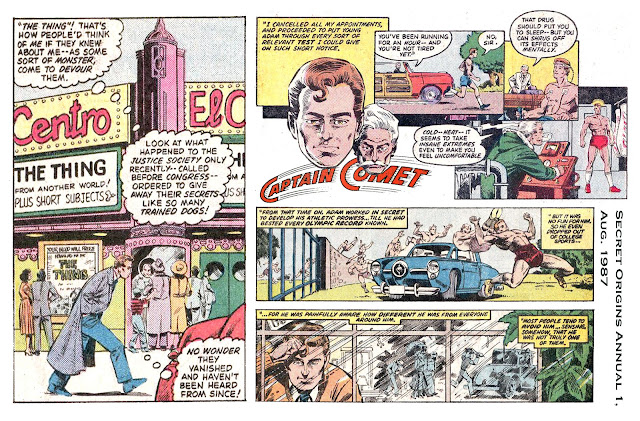February 1952: Telepathy by Television
The original science fiction
novel, Mary Shelley’s Frankenstein,
is the explicit inspiration for Beware
the Synthetic Men! in Strange
Adventures 17 (Feb. 1952).
Rumors of green men in Washington,
D.C., prompt a televised government spokesman to brand them a myth, but Captain
Comet telepathically sees through that lie.
“No reason to fear,” broadcasts
Dr. Stanton, the “nation’s science-defense chief” (didn’t know we had one).
“Great Galaxy!” says Captain
Comet. “He’s saying one thing — thinking the exact opposite!”
For a mutant 100,000 years ahead
of his time, Captain Comet could be remarkably naïve about politics. Or is it
simply that morally and intellectually advanced beings like Adam Blake would
necessarily see the ultimate futility of lying?
“What’s most interesting about this
tale is the use of television,” observed comics historian Michael E. Grost. “One
of Captain Comet’s seemingly endless powers is the ability to read thoughts.
After all, he explains that thoughts are merely electric waves, which his
advanced senses can pick up. But it turns out that thought waves are actually
broadcast by TV, along with the picture and sound, so while watching at home
Captain Comet can read the thoughts of a man who is broadcasting on live TV,
right over the air waves! Green Lantern’s ability to look into people's minds
and see the truth is one of his most important capabilities. Here, Captain
Comet can do something similar.”
Note that in 1945, we had fewer
than 10,000 TV sets in the United States. By 1952, that figure had risen to nearly
17 million.
“Television was so new in 1952
that it was still regarded as an sf invention,” Grost wrote. “It seemed
plausible that it might have undiscovered properties or potentials, such as
thought broadcasting. There are also aspects of social commentary or even
satire here. The story explicitly contrasts what is being said by the
broadcaster to what he is actually thinking. Even in the 1950s, people were
skeptical about this.”
Comet learns the Pentagon’s goal
was to be able to build “synthetic men-warriors who cannot be killed.” The
prototype artificial men, named for the first five letters of the Greek
alphabet, are made of “neoplasm,” which makes them immune to bullets and poison
and gives them super strength.
Mary Shelley’s novel left us with two
enduring themes — one about the creation of artificial life, and the other
about how advancements in knowledge can have unintended and disastrous consequences.
The second comes into play here
when the scaly green super-warriors decide serving human purposes isn’t such a
hot idea. They tear out their prison bars and escape to the countryside,
intending to create a new race of beings.
Tearing down the surrounding
telegraph poles, the green men isolate and seize the small town of Calnit near the
Great Salt Lake.
“Th- they walked through a hail of
bullets!” exclaim the local inhabitants.
“You humans will live — as our
slaves!” the green men reply.
But Captain Comet, knowing that
the synthetics feed on pure calcium nitrate, had reasoned that Calnit might be
one of the places where the green men would hide. With his encyclopedic brain,
Comet was aware that the white oolitic sand near the Great Salt Lake is made up
of concentric layers of calcium carbonate.
Flying to Utah in his rocket ship,
Comet confronted the menace unleashed by what Eisenhower would term the
military-industrial complex.
“Bah! He is human, is he not?”
sneered one of the synthetics. “Therefore bullets will slay him! Fire…”
But although the superhero’s
telekinesis slows the bullets to a harmless speed, he finds his telepathic
powers do not work on the synthetics, who mob him.
Pretending to be overcome, the Man
of Destiny plays for time until he can deduce the green men’s weakness. Then, conspiring
with the townspeople, he traps the synthetics in a small supply room that he
floods with pure oxygen.
“My clue lay in their food —
calcium nitrate,” Comet explains. “Nitrates mean nitrogen and I deduced that it
was the nitrogen in the air which they breathed — not the oxygen! Just as
humans would perish in air of pure nitrogen, so the synthetics couldn’t survive
in pure oxygen! It combined with the calcium in their bodies to form calcium
carbonate — which is the formula for marble!”
Mounted on a hilltop pedestal,
with a plaque, the five frozen beings end up a tourist attraction for Calnit.
The origin of this story can be
traced to the shores of Lake Geneva, Switzerland, on the evening of June 16,
1816, when Lord Byron made a suggestion.
Why not have everybody write a
ghost story?
“Everybody” would include Byron
himself, physician John William Polidori, actress Claire Clairmont, poet Percy
Shelley and his 18-year-old wife Mary.
“Mary Shelley, for her part, could
think of nothing that night — or for several nights thereafter,” noted Peter Haining.
“It seemed as if the whole idea would be a failure.
“Then, unexpectedly, as she lay in
bed about a week later in the half-world between waking and sleeping, Mary
experienced a vivid flight of imagination in which she saw a scientist create
artificial life in a laboratory. Here was her theme, she knew at once, and the
next morning took up her pen.
“The result of that dream was Frankenstein. But not the famous novel
that we know today. Mary, true to the instructions of the challenge, merely
wrote a short story around her nightmare which she then showed to Byron and
Shelley. Her host dismissed it with hardly a glance; her husband, though, read
the few pages rather more carefully, and then declared it was not really a
story. She should perhaps try to turn it into a novel.”
That she did, and the result was
published two years later. “What she also did that night was to give life to
the creature who ever since has walked through all our days and nights and
illustrations and moving pictures…”
And comic books, Haining might have added.
And comic books, Haining might have added.




Comments
Post a Comment